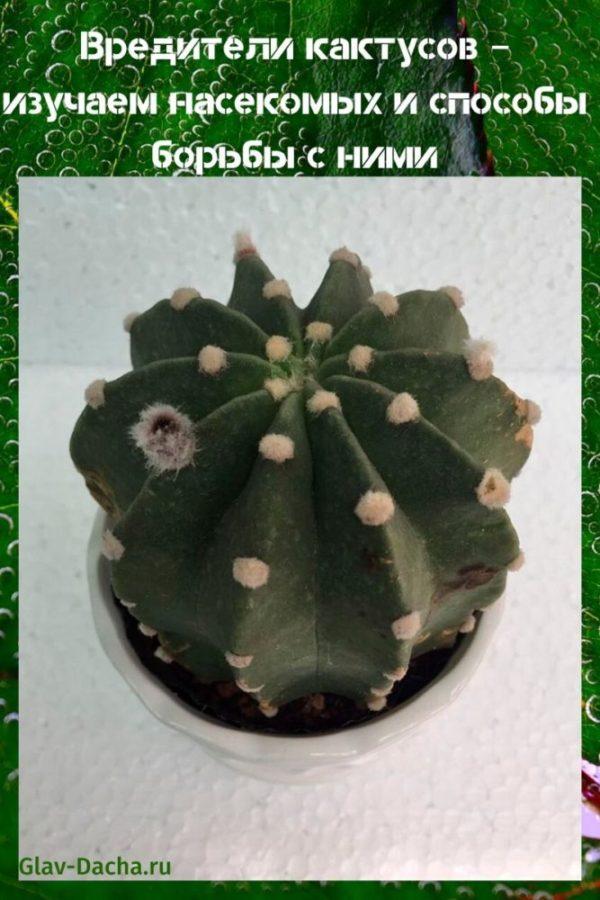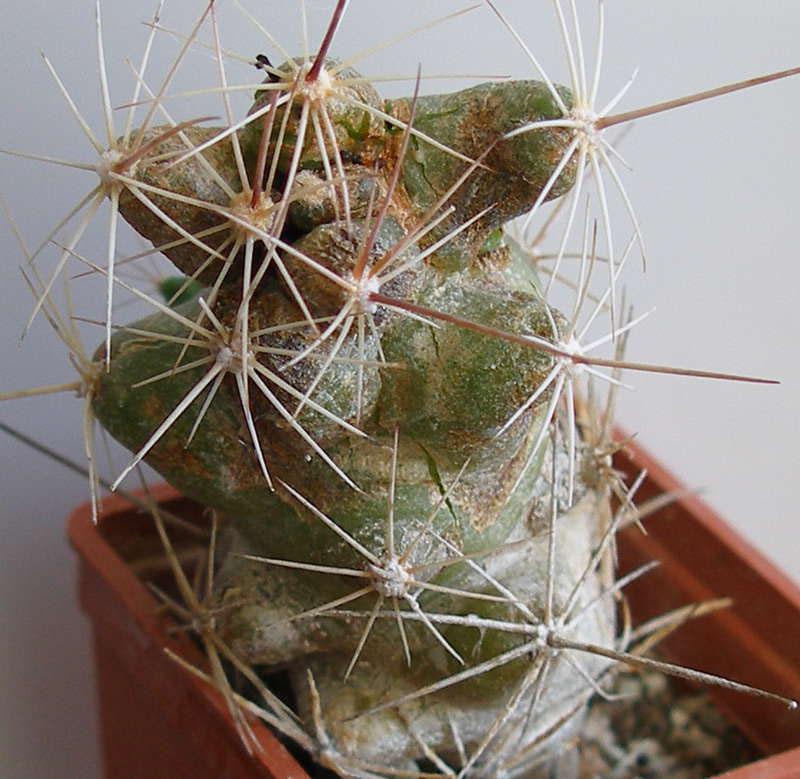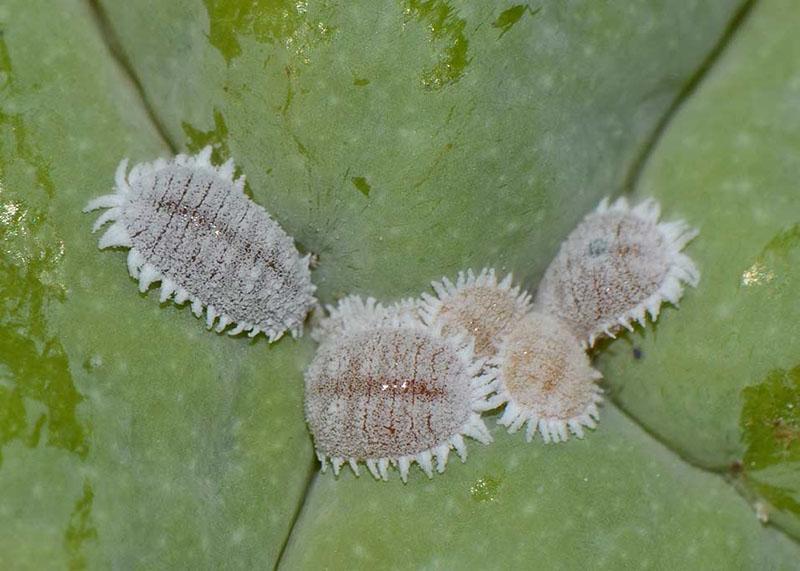Cactus pests - we study insects and how to deal with them
 Cactus pests can destroy the entire collection. More often they parasitize on weakened, diseased plants, and also infect those specimens that have received insufficient care. Succulents are a tasty morsel for insect pests, as these plant species contain carbohydrate and starchy substances. Preventive measures and competent agricultural technology will help to prevent the attack of insects.
Cactus pests can destroy the entire collection. More often they parasitize on weakened, diseased plants, and also infect those specimens that have received insufficient care. Succulents are a tasty morsel for insect pests, as these plant species contain carbohydrate and starchy substances. Preventive measures and competent agricultural technology will help to prevent the attack of insects.
The main pests of cacti and the reasons for their appearance

Cactus pest insects are not uncommon on succulents. They can move to cacti from other indoor plants, appear after transplanting, provided that the soil has been contaminated, and also "come" with a cactus from a store or nursery.
When buying a cactus, you should pay attention to its appearance. Of course, most parasites are too small, and it will be difficult to see them with the naked eye, and even more so to find the larvae. But some traces of pests on the cactus must be present. You need to be wary when you see white fluffs, black or white spots, small dots. You need to inspect not only the plant itself, but also the soil - some types of parasites live on the substrate.
What insect pests threaten succulents? The most common types are:
- root and mealybug;
- spider mite;
- shield and false shield;
- nematodes;
- thrips;
- aphid (greenhouse or leaf);
- whitefly.
These parasites can and should be fought, but first you need to learn more about them in order to understand which way to choose.
Bug on a cactus
 The mealybug on a cactus is quite dangerous for any plant species. It is not detected immediately, but when the succulent has suffered enough from insects and their larvae. Distinguish between mealy and root bugs. In addition, there are species that prefer to breed on succulents.
The mealybug on a cactus is quite dangerous for any plant species. It is not detected immediately, but when the succulent has suffered enough from insects and their larvae. Distinguish between mealy and root bugs. In addition, there are species that prefer to breed on succulents.
The appearance of the pest is unremarkable. It has an elongated body up to 5 mm in size. The color is gray, white hairs are visible on the body. There are legs on the sides. It is difficult to notice them, but some species, when laying eggs, wrap them in a white cocoon that looks like cotton wool.
 The root worm can live on the roots, in the root zone, on the stems of the plant, if it has managed to multiply enough. Often these insects can be found in the areoles, on the ribs of a cactus. They like to take shelter. It is also difficult to recognize them because they rarely move, and if they do, it is very slow.
The root worm can live on the roots, in the root zone, on the stems of the plant, if it has managed to multiply enough. Often these insects can be found in the areoles, on the ribs of a cactus. They like to take shelter. It is also difficult to recognize them because they rarely move, and if they do, it is very slow.
With severe damage, succulents lag behind in growth, wither, parts of the plant lose turgor and the usual color. The worm reveals itself as a white powdery bloom on the cactus, in cotton balls. Treatment should begin with the mechanical removal of parasites and their larvae.
Cactus pests - spider mites
 The common spider mite can only be found on a cactus with a magnifying glass. Its size is no more than 0.25 mm, while the parasite leads a sedentary lifestyle. Getting on a succulent, it tries to settle higher and prefers the young parts of the plant. The pest feeds on cactus cells, and the voids that appear are filled with air. Because of this, the process of photosynthesis is disrupted, and the plant loses its usual appearance.
The common spider mite can only be found on a cactus with a magnifying glass. Its size is no more than 0.25 mm, while the parasite leads a sedentary lifestyle. Getting on a succulent, it tries to settle higher and prefers the young parts of the plant. The pest feeds on cactus cells, and the voids that appear are filled with air. Because of this, the process of photosynthesis is disrupted, and the plant loses its usual appearance.
At this stage, the owner should be alerted by the appearance of dark spots, which gradually grow as tissue is damaged. Through a magnifying glass, it is noticeable that the tissues are dead, and accordingly they will not recover after treatment. Affected areas of the cactus may become less visible as new, healthy tissue begins to appear.
A spider mite on a cactus is also noticeable by a thin cobweb entangling the damaged plant. Under favorable conditions for him, he gives up to 20 generations per year. Indoors, the parasite most often appears due to the wind, which carries it in the warm season into an open window from front gardens or vegetable gardens.
Shield and false shield
 This type of pest is more often found on prickly pears, columnar and leaf cacti. They appear as small raised brown spots on parts of the plant. These are some kind of shields under which parasites are hiding. Adult insects are immobile, multiply and lay eggs under the scutellum. When the larvae hatch, they gradually creep all over succulent.
This type of pest is more often found on prickly pears, columnar and leaf cacti. They appear as small raised brown spots on parts of the plant. These are some kind of shields under which parasites are hiding. Adult insects are immobile, multiply and lay eggs under the scutellum. When the larvae hatch, they gradually creep all over succulent.
It is clear that the wax shield is a reliable protection for these pests, which means that conventional means of controlling adult insects do not work on them. Experts recommend acting on them mechanically, cleaning the plant from parasites with a cotton swab dipped in alcohol. It is important to take precautions so as not to spread eggs and larvae into parts of the plant.
After mechanical treatment, you can act on the cactus with insecticidal agents, and then periodically inspect it in order to repeat the procedure if necessary.
Any indoor plant, including cacti, must be inspected at least once a week for diseases and pests. Treatment must begin with removing the affected succulent from other plants.
Cactus pests - nematodes
 It is very difficult to fight nematodes. In the first place, suspicion should be caused by the stalled plant growth. If at this stage you do not take action, do not detect and recognize the pest, then the root system begins to suffer, which sooner or later will lead to the death of the plant.
It is very difficult to fight nematodes. In the first place, suspicion should be caused by the stalled plant growth. If at this stage you do not take action, do not detect and recognize the pest, then the root system begins to suffer, which sooner or later will lead to the death of the plant.
The root nematode attaches to the roots of the cactus, forming a significant thickening. Later, larvae appear from them, which take root inside the root. If there is a suspicion of a nematode infestation, carefully remove the plant from the pot and carefully examine the root system.
The roots exposed to the parasite have noticeable formations. It is recommended to shake off the remaining soil from the roots into a container of water. Soon, yellow oval cysts will appear on the surface. It is difficult to get rid of them, as they hide in the root system. Experts advise trimming the roots and cleaning the root collar, and only then treat the cactus with drugs.
Aphid
 Aphids on prickly pear or other cactus species are considered the most common pest. Even if you carry out regular preventive treatment of a succulent, there is a high risk of finding aphids on it. The insect is rather small, elongated, mobile, of different colors.
Aphids on prickly pear or other cactus species are considered the most common pest. Even if you carry out regular preventive treatment of a succulent, there is a high risk of finding aphids on it. The insect is rather small, elongated, mobile, of different colors.
It feeds on plant sap, sucking sap from it with a small proboscis. As a result, black spots appear on the cactus, which injure the entire plant. An adult female lays eggs, she can move to other indoor plants. Therefore, as soon as aphids are found on any specimen, it must be isolated from the rest.
When succulents appeared in the collection of indoor plants, you need to bring their content as close as possible to natural conditions. They need to create a microclimate to which the cactus is accustomed to in its homeland.
Thrips
 Thrips are small insects with a yellow-brown body. They inhabit the upper part of the plant. They are easily recognized by the silvery or white spots on the cactus. They move quickly, moving from one plant to another.Before processing the succulent with special means, it is necessary to identify the lesion focus. As a rule, to completely rid the cactus of this pest, several procedures and periodic inspection will be required.
Thrips are small insects with a yellow-brown body. They inhabit the upper part of the plant. They are easily recognized by the silvery or white spots on the cactus. They move quickly, moving from one plant to another.Before processing the succulent with special means, it is necessary to identify the lesion focus. As a rule, to completely rid the cactus of this pest, several procedures and periodic inspection will be required.
Prevention and treatment
 As soon as one of the specimens shows white or dark spots, silvery bloom or white fluff on the top of the cactus, you need to make a thorough examination, and also isolate the plant from the rest. Further treatment will be required. First of all, it is necessary to remove insects and larvae mechanically, and then act with special means.
As soon as one of the specimens shows white or dark spots, silvery bloom or white fluff on the top of the cactus, you need to make a thorough examination, and also isolate the plant from the rest. Further treatment will be required. First of all, it is necessary to remove insects and larvae mechanically, and then act with special means.
 What to do if a cactus dies and is it worth reanimating in this case? You can try replanting the plant by removing all affected parts of the cactus, including the roots. During the procedure, the instrument should be disinfected, and the sections should be treated with cinnamon or activated carbon. After that, it is important to dry the plant for 2 days.
What to do if a cactus dies and is it worth reanimating in this case? You can try replanting the plant by removing all affected parts of the cactus, including the roots. During the procedure, the instrument should be disinfected, and the sections should be treated with cinnamon or activated carbon. After that, it is important to dry the plant for 2 days.
 Despite the fact that the appearance of cacti is often not a cause for concern, like any other plant, they can be attacked by parasites. Proper care will help prevent this. It is important to create for the succulent all the necessary conditions for full growth and development.
Despite the fact that the appearance of cacti is often not a cause for concern, like any other plant, they can be attacked by parasites. Proper care will help prevent this. It is important to create for the succulent all the necessary conditions for full growth and development.